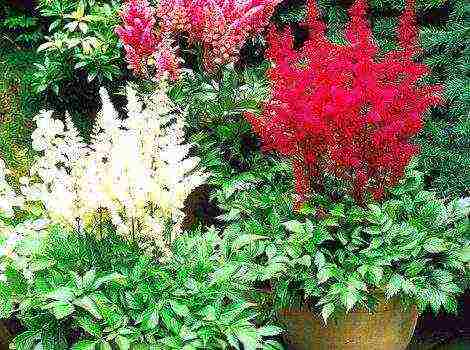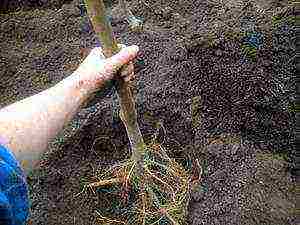Content
- 1 Planting and caring for the crested in the garden
- 2 Growing corydalis from seeds
- 3 Reproduction by dividing the bush
- 4 Crested species with photos and names
- 5 Corydalis in landscape design
- 6 The Legend of the Corydalis
- 7 Varieties and types
- 8 Corydalis planting and care in the open field
- 9 Corydalis transplant
- 10 Planting corydalis in autumn
- 11 Corydalis growing from seeds
- 12 Diseases and pests
- 13 Corydalis features
- 14 Corydalis planting in the open field
- 15 Crested Crested Care in the Garden
- 16 Types and varieties of corydalis with photos and names
Corydalis (Corydalis) is a perennial herb belonging to the Dymyankovye family. It is an ephemeroid - it has a short growing season. It germinates quickly, blooms, gives fruit, and then the aerial part dies off completely. It appears in the forest in April, and by the end of May and beginning of June you will not find traces of the corydalis.
About 200 species of Corydalis are common in China, the Himalayas, they can be found in the temperate latitudes of the entire Northern Hemisphere. There are 3 varieties growing in our forests: Corydalis hollow, dense and Marshall.
Botanical description
The root system is tuberous. Every year, a new one is formed inside the old rounded nodule, and that becomes its shell. The fleshy stem is 15-25 cm long. The stem is densely leafy. The leaves are cut twice or thrice, painted in bright green, may have a bluish tint. Loose racemose inflorescences appear on the tops of the shoots - they rise like candles. Each individual flower is elongated from the base, ends with 4 small petals, the tips of the petals are slightly curved outward. The color can be yellow, pink, blue, purple, white.
Corydalis is the official name of the plant, given by the name of the crested lark, precisely because of the shape of the flowers that resemble a bird's crest.
The fruit is an oblong capsule resembling a pod. The seeds are large, black-colored. Forest ants eat the succulent seed plant, collect seeds, thereby spreading the corydalis.
Corydalis is an excellent honey plant. It can only be pollinated by insects with long proboscis (bumblebees, for example). Due to its spectacular decorative appearance, it has become popular in gardening.
Corydalis hollow is used in folk medicine due to the presence of alkaloids. The decoction and extract are used as an analgesic, anti-inflammatory, hemostatic agent.
Planting and caring for the crested in the garden
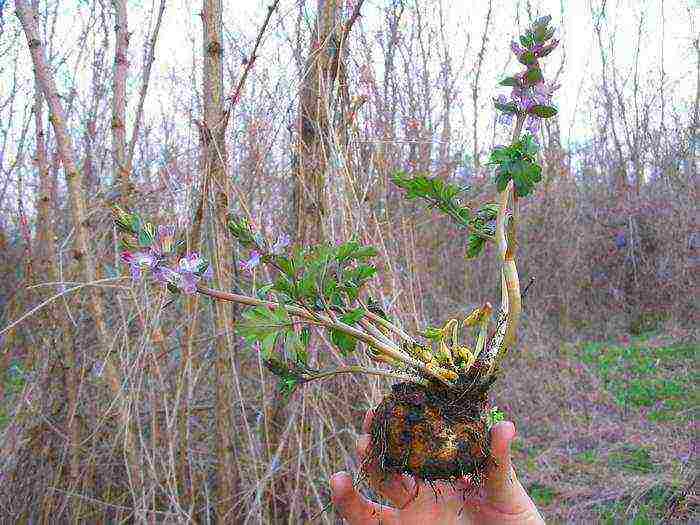
How to plant a crested tuber in a garden photo of a tuber
- Plant the tubers during the period of growth and flowering, because after flowering, the ground part quickly dies off and it is very difficult to find the roots.
- Deepen large nodules by 10-15 cm, small ones by 5-7 cm.
- The soil requires a loose, fertile, slightly acidic reaction. If the soil is heavy, add coarse sand to dig.
- Choose an area with diffused lighting without stagnant moisture.
During the period of active growth, the plant is content with moisture from the precipitation. The roots are located deep underground, so they will not be affected by summer drought.
Leaving after flowering and wintering
When the stems and leaves are dry, they should be cut off. Shelter for the winter is not required, the plant is frost-resistant and winters wonderfully in the middle lane. In colder regions, it is recommended to cover with fallen leaves and spruce branches.
Corydalis growing from seeds
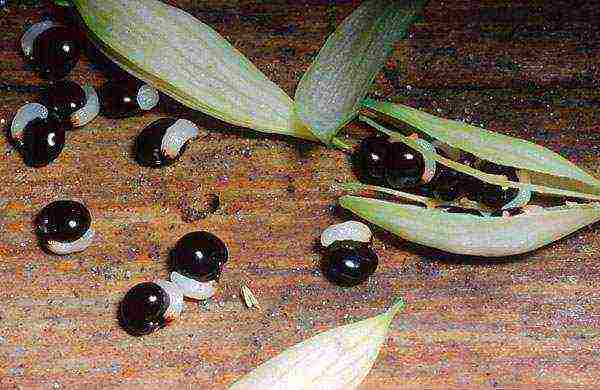
Corydalis seeds photo
Seeds quickly lose their germination, so sow immediately after harvest.
- Sow into containers of sand and peat mixture.
- Seeds are spread over the surface, lightly sprinkled with sand or loose soil.
- Pour from a spray bottle, cover with glass or a bag.
- Every day you need to ventilate, water from a spray bottle as the top layer of the earth dries up.
- In the first year, only cotyledons (young leaves) may appear, and then there will be a dormant period. Be patient! Provide a cool content with sparse watering and moderate lighting.
- With the arrival of spring, young Corydalis will begin to grow again, it will be possible to fertilize with nitrogen fertilizers in half the concentration.
- Plant young plants by transferring them into open ground after the end of night frosts at a distance of 10-15 cm.
Reproduction by dividing the bush

How to divide a crested bush photos of tubers for transplant
Some species have powerful rhizomes and tubers. Plant them after flowering ends.
Large tubers can be divided into parts. Each part must have a growing point. Sections must be treated with a fungicide, then deepened into the soil by 6-7 cm.
Crested species with photos and names
The genus has about 320 species. They are divided into groups according to growing conditions (desert, Asian, etc.). Consider the species grown in the gardens of our latitudes.
Corydalis dense or Solida Corydalis solida

Corydalis dense or Hallera Corydalis solida photo
The natural habitat is sunny edges and light crowns of trees in the European part of Russia and Western Europe. The small tuber is 15 mm in diameter. The stem extends by 10-25 cm. 2 pinnately dissected leaves extend from the base of the stem. The dense, cylindrical inflorescence blooms in mid-April. The color of the flowers is pink-purple.
Corydalis hollow Corydalis cava
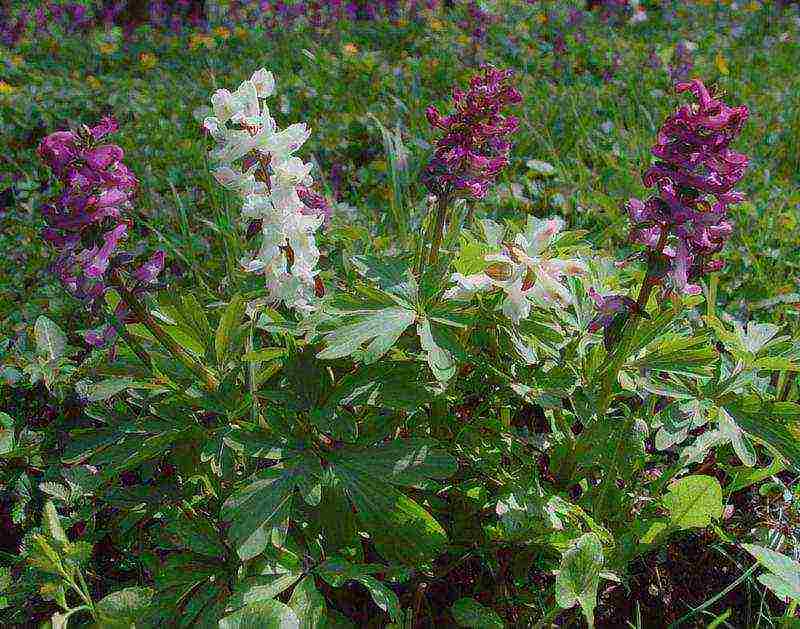
Corydalis hollow Corydalis cava photo
Prefers the edges of deciduous-coniferous and broad-leaved forests in Europe and Asia Minor. The height of the stem reaches 40 cm. The leaf plates are triangular in shape and consist of pinnately dissected leaves. The flowers are dark purple in color.
Corydalis Marshall Corydalis marschalliana
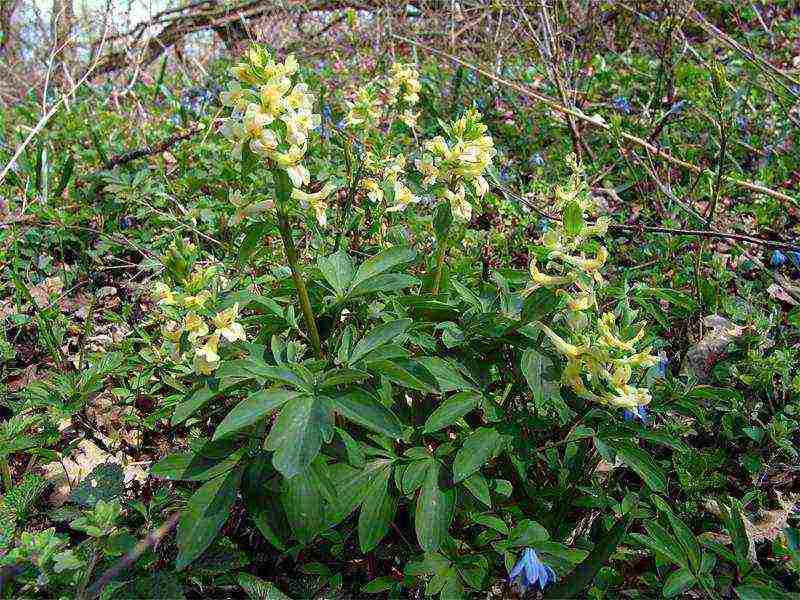
Corydalis Marshall Corydalis marschalliana photo
Distributed in the South-Eastern part of Europe. Stems 15-30 cm high are reddish-green in color. The leaves are tripartite, colored green with a bluish tint. At the end of April, a 25 cm long peduncle appears. The flowers have a delicate creamy yellow color.
Corydalis dubious Corydalis yanhusuo
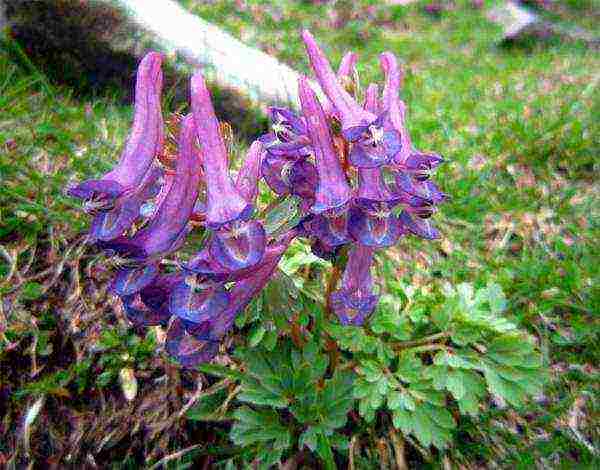
Corydalis dubious or Yanhusuo Corydalis yanhusuo photo
Distributed in the forests of Kamchatka, Sakhalin, the Kuril Islands. The stem length is 10-15 cm, they are covered with a bluish bloom. The flowers are sky blue. Blooms in late April.
Corydalis noble Corydalis nobilis

Corydalis noble Corydalis nobilis photo
A herbaceous plant about 80 cm high. The leaves are pinnately dissected, painted in bright green. Inflorescences bloom in early May. The yellow flowers are bordered with a purple stripe.
Corydalis yellow Corydalis lutea
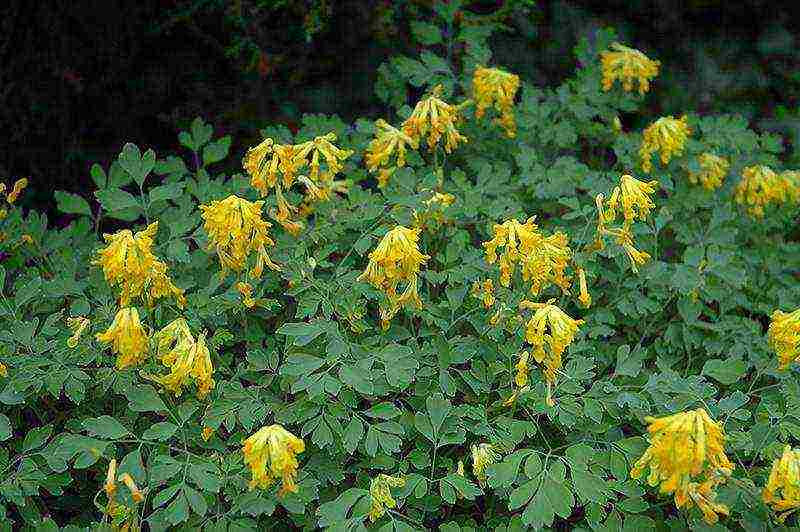
Corydalis yellow Corydalis lutea photo
The habitat is the western part of Europe. Has a creeping rhizome. The stem is 10-40 cm high. At the base of the stem, dissected leaves of a gray-green color are attached. Flowers bloom immediately after the snow melts. They are sunny yellow in color.
Corydalis in landscape design

What does a crested flower look like?
Corydalis is popular as an ornamental garden and park culture. Bright flowers will decorate park lawns, any flower beds, flower beds. Looks good on alpine slides, rocky gardens. Combines with tulips, crocuses, snowdrops, hosta.
The Legend of the Corydalis
According to legend, the spring larks started a fight, in which they tore each other with crests, which fell to the ground and sprouted with beautiful flowers.
According to an ancient Slavic legend, a witch lived in the forest, who flew around her possessions every night. At dawn she returned to the hut. The cockerels interfered with her rest, announcing the coming of a new day with their cry. She was so angry that she turned them into silent flowers. The people also call the flower "chickens" and "cockerels".
Corydalis is a numerous genus of herbs in the Poppy family.The main habitat of which is the temperate belt of Eurasia and North America. This plant does not require special care and has many advantages: it withstands high frosts, has a high decorative effect and early flowering. The downside is the high probability of disease and pest damage.
Corydalis are ephemeroids, that is, they live for a short period of time when conditions are most favorable for development, and after that the upper part of the plant dies, while the tubers remain in the ground. But in a short period of life, they delight us with their white, yellow, blue or red flowers.
Varieties and types
Representatives of this genus can be divided into several groups, differing in the possibility of growing them as a flower crop and for care.
The least problems when growing in central Russia are caused by forest species, the most unpretentious of all:
- Corydalis hollow,
- Haller or dense,
- Caucasian,
- Large-flowered,
- Marshall,
- Low,
- Dubious,
- Intermediate,
- Narrow-leaved.
This type is the most common and can be easily grown among deciduous trees. Corydalis grow well on loose clayey soils saturated with leaf humus or sandy loam. Do not tolerate excess moisture.
It is more difficult to cultivate the Corydalis growing in the mountains and deserts of Asia:
- Corydalis Kashmir,
- Dissected,
- Emanuel.
Tuberous plants are referred to the above two types, but there are a small number of corydalis with rhizomes:
- Corydalis yellow,
- Sulfur yellow,
- Noble.
And very rarely in cultivated form you can find evergreen corydalis and touch-me-not corydalis.
And last but not least, it is worth mentioning the species that have appeared quite recently and have not yet become widespread:
- Corydalis sinuous,
- Corydalis high.
In the wild, they grow only in Sichuan in China, so for a long time they were not known to a wide range of gardeners.
Separately, it is worth mentioning hybrid forms that are obtained by crossing different species. They have different characteristics from their parents.
On packages with such seeds, the hybrid corydalis will always be written, and then the species from which it was obtained may already be indicated.
Some crested species have already become material for new varieties. For example, the narrow-leaved Corydalis became the basis for obtaining the Blue (Blue) series:
- Corydalis Blue Heron (Blue Heron),
- Corydalis Blue Line (Blue Line).
to the table of contents
Corydalis planting and care in the open field
The rules for caring for a crested hen are not at all burdensome. This plant is ephemeroid, just like the snowdrop, and prefers to avoid problems rather than worry about them. They can grow in different places and for different reasons they can disappear.
The most common forest species bloom when the trees in the forest are not yet foliated, and after that they begin a dormant period, since they cannot grow under the shade of dense foliage.
The crops that live in dry areas avoid the summer heat, and those that grow in the mountains and in the tundra, respectively, synchronize with the weather of their area and try to bloom and give seeds as soon as possible, because the cold can come even in the summer months.
As you can see, this plant has a fast developmental rhythm, but the care requirements are still different for different types. For example, during the growing season, plants of all types require quite a lot of water, but during dormancy, the moisture requirements are different. Forest, tundra and mountain species do not like dryness, and desert ones, in turn, do not like high humidity.
The forest type does not require bright lighting and grows better in shady areas, while mountain views, on the contrary, require bright light. There are also preferences for soils: forest species need loose and organic-rich soils, and Asian mountain species need clay substrates with drainage.
Erythronium, also called kandyk, is well suited for group plantings when grown and nursed in the open field. Not picky about care and reproduces well. You can find tips for growing and caring in this article.
to the table of contents
Corydalis transplant
Following fruiting, Corydalis begin to turn yellow and dry out, after which they have a dormant period. At this time, the tubers remain in the soil, they are not afraid of practically any external influences and sometimes it is even difficult to determine where the plant is located while the dormant period is in progress.
At this time, you can easily transplant the flower to a new place by transferring it along with an earthen lump. Also, a transplant can be performed during the growing season, but then there is a high probability that the green part will come off and the flower will prematurely fall into a dormant period.
to the table of contents
Planting corydalis in autumn
In the summer and autumn, resting tubers are sold in markets and shops. They should be stored in a perforated plastic bag filled with sawdust. Only firm and full of juice nodules can be planted in the ground, dry and wrinkled nodules can not be planted, unless it is a desert species, the tubers of these crops may be slightly dried.
When planting, the tubers of plants are deepened depending on their size. Small specimens are buried by about 6 cm, large ones by 12-14 cm. The choice of a place for planting and the soil is chosen in accordance with the type of plant.
Forest forms can be grown together with snowdrops, they thrive together well.
If the summer is too humid, even the tubers of forest forms may suffer, it will be advisable to dig them up and dry them for 30 days at room temperature. You can also build a greenhouse that will protect the area with tubers from rain.
to the table of contents
Corydalis growing from seeds
Among the ways of reproduction, the main one is seed. The division of the rhizome is inaccessible for almost all species, except for the Bush and Kashmir corydalis, on which small new tubers nevertheless appear. But in other species, the formation of young nodules is extremely rare, so you should not rely on it.
The seed method is quite reliable if a couple of conditions are met.
The first is sowing immediately after harvest, since the seeds lose their germination within 6-8 days. It is also important to collect them in time: the crested seeds are very fond of ants and immediately collect them as soon as they spill out of the boxes.
The second condition is a constant wet content, since when they dry out, the seeds immediately lose their germination, so it is better to sow in pots, where it will be easier to care for them.
In general, the corydalis normally reproduces by self-seeding, unless there are ants nearby, in this case there will be much less seedlings.
to the table of contents
Diseases and pests
Corydalis is susceptible to various pests and diseases.
Viruses can be identified by the appearance of spots and patterns on foliage, even because of them, she can start curl up or hide in small growths... As soon as you notice such symptoms, immediately remove the infected individuals, since they cannot be cured, and in the future they will infect the entire flower bed.
Fungi manifest themselves in dark spots on foliage, sometimes rust may appear, in the form red spots... The affected parts are cut off and burned, and the plants themselves are treated with fungicides, for example, Bordeaux mixture.
Dangerous pests are moles and mice... They gnaw the tubers, which causes rot. Rodents are destroyed by making traps on the site and flooding their holes with water. Affected tubers are pruned, treated with wood ash and dried a little.
To chase away slugs, it is necessary to scatter crushed eggshells or lime over the area.
Bulb nematodeis probably the most problematic pest of all. It infects the tubers of the plant, leaving ring marks behind. Foliage because of defeat starts to turn yellow.
The affected individuals are removed, and the rest are dug up and kept for up to 30 minutes in water at a temperature of 55 ° C. Further, the roots can be planted in another area, but where the corydalis grew before, it will not be possible to plant bulbous plants for a long time.
As you can see, a number of difficulties can arise when growing a corydalis, but, nevertheless, due to early flowering, high frost resistance, lack of need for fertilizers and, as a rule, rare watering, the corydalis is becoming an increasingly frequent guest in our flower beds.
to the table of contents
The herbaceous corydalis (Corydalis) is a member of the Poppy family. In nature, it is found in regions with a temperate climate of the Northern Hemisphere. The scientific name of this plant is derived from the Greek word for "helmet", this is due to the shape of the flowers of the corydalis. This genus unites about 320 species. The greatest diversity of species (about 200) is observed in the territory of Central and Western China, as well as the Himalayas, where Corydalis grow at an altitude of 3000–5000 meters above sea level. These plants began to be cultivated relatively recently, or rather, in the 19th century. They were previously imported from Central Asia, the Himalayas, Siberia, Tibet, but most often from China. Today they are quite popular among gardeners, as well as, for example, dahlias, tulips and phloxes. And all due to the fact that such a flower is not only very beautiful, but also resistant to frost and diseases, undemanding to care, and it also has medicinal properties.
Corydalis features
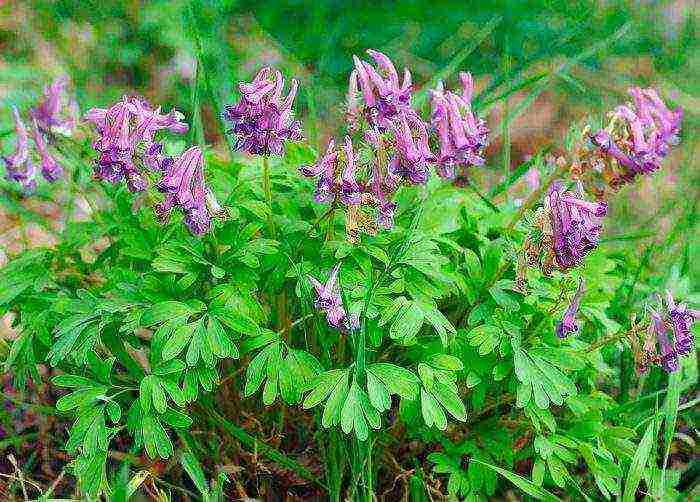
The flowering Corydalis plant is a perennial and an annual. The rhizome of such a plant is quite massive, it is located at a rather great depth and consists of branched processes. On individual shoots, the formation of rounded tubers is sometimes observed, inside which there are nutrients. The height of erect shoots can vary from 0.15 to 0.45 m. At the base of the stems there are 2–4 fern-like leaf plates of a dark green color with a bluish bloom. Leaves can be twice or three times complex, the shape of the lobes is triangular or rounded, and each of them has its own petiole. The formation of racemose cylindrical inflorescences at the tops of the stems is observed in mid-April. The inflorescences include 5–35 long flowers that can be colored pink, lilac, white, purple or yellow. Flowers have corolla length from 1.5 to 2.5 centimeters, pointed sepals are small, and bracts are relatively large. All flowers have rather long spurs, inside of which there is nectar. It can only be obtained by those insects that have a long proboscis. The fruit is an oblong box with small glossy black seeds inside. Each seed has a fleshy growth that ants simply adore. As a result, ants can drag these seeds over a rather long distance.
Corydalis begins to grow in March. Its flowering begins after the soil warms up to 3-4 degrees. The flowering period is approximately 20 days. Seed ripening is observed in June, after which the dying off of the part of the plant that is above the ground occurs. In landscape design, these plants are most often grown with other primroses, for example: crocuses, muscari, chionodox, galanthus and early tulips.
Corydalis planting in the open field
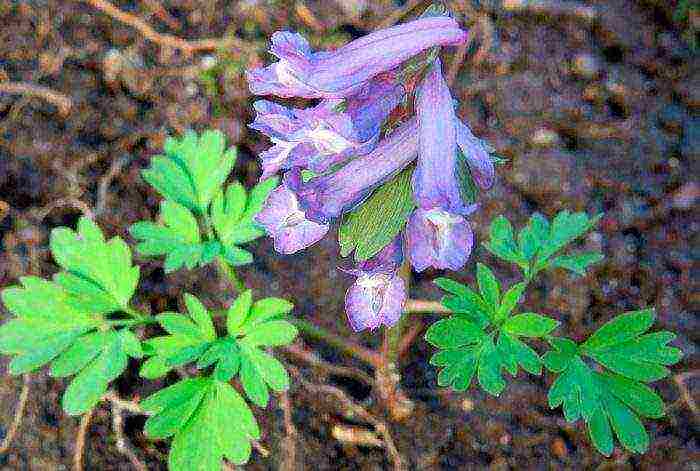
What time to plant
As a rule, corydalis planting material is sold at a time when its tubers are dormant, or rather, from the second half of June to September. It is during this period of time that it is recommended to plant this crop in open soil. The acquired planting material must be thoroughly examined.You should choose dense and juicy tubers. The tubers of the Central Asian species of this plant can be slightly dried, it does not harm them.
When choosing a site for planting, you should pay attention to which group the species of corydalis you grow belongs to. So, for example, experts advise Chinese, mountain and alpine species to grow in an open, illuminated area, with well-drained sandy loam soil, while it should be located on a hill or hill. And forest species are recommended to be planted in a shaded area with loose humus soil. It must be necessarily neutral or slightly acidic.
Landing rules
There is nothing difficult in planting and growing the corydalis. Before planting, the site must be prepared. If the soil is dense and excessively heavy, then during digging it is necessary to add fine gravel or crushed stone to it. It should be remembered that when moisture stagnates in the soil, rot forms very quickly on the roots. To avoid this, you should make sure that excess liquid drains off the site quickly enough.
The depth to which tubers should be planted directly depends on their size. Large tubers should be planted to a depth of 10 to 15 centimeters, and small ones - 5–7 centimeters deep. The planted tubers need abundant watering.
Crested Crested Care in the Garden

When growing the corydalis in the garden, it should be watered, weeded, fed, loosened the soil surface and protected from pests and diseases in a timely manner. But it should be borne in mind that different types of care requirements and preferences may differ.
How to feed and water
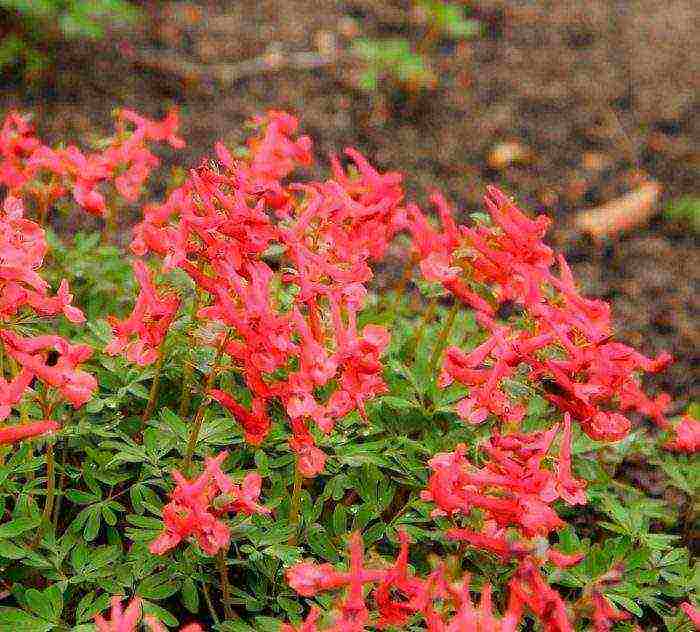
In the first weeks of spring, when the corydalis begins to grow, as a rule, the soil is rather moist from melt water, so the plants will not need to be watered. After the earth dries out, the plants will need to be watered systematically. It should be noted that alpine and desert species should be provided with moderate watering, since they react negatively to stagnant moisture in the root system, while a short drought does much less damage to the plant. It must be remembered that any of the corydalis species reacts extremely negatively to stagnant water in the ground, in this regard, the land on the site must be well-drained. When the bushes are watered, you need to loosen the surface of the site, while removing the weeds. To reduce the number of weeding, watering and loosening, the surface of the site must be covered with a layer of organic mulch.
Only forest species of corydalis need feeding, while compost or leaf humus should be added to the soil during digging before planting. Also in the spring, you can mulch the surface of the site with organic matter.
After the bushes have faded, their parts located above the ground turn yellow over time, and their dying off is observed. To remember where they grew, you need to mark each bush by sticking a peg next to it. This culture is distinguished by a fairly high resistance to frost, so it does not need shelter for the winter. However, it should be borne in mind that the Chinese corydalis can die if the air temperature drops below minus 23 degrees.
How to transplant and propagate
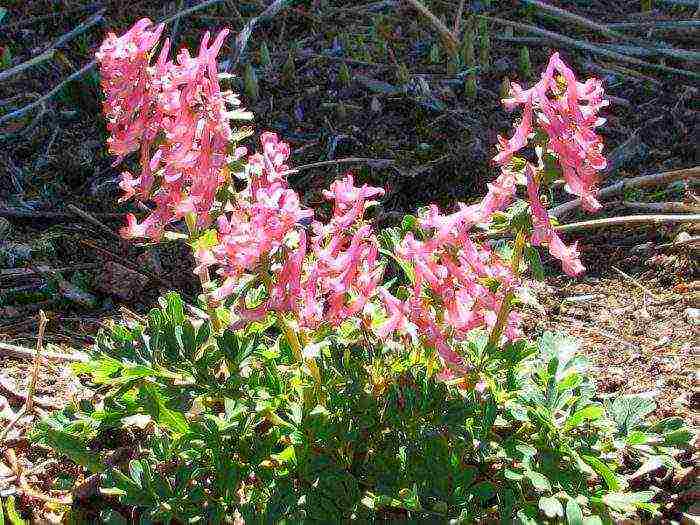
It is recommended to transplant this primrose during the period of its rest. But even during the flowering period, the corydalis bushes tolerate this procedure quite well. However, when transplanting, a part of the flowering bush located above the ground can come off quite easily, in which case the tubers will begin a dormant period earlier than usual. They move the bushes to a new place along with a lump of earth.
For the reproduction of such a plant, seeds, tubers, and also the method of dividing the rhizome are used. On the rhizomes, tubers are formed only on the corydalis of Kashmir and Bush. You can divide the rhizome in the spring, as well as from the middle to the end of the summer, and do this during plant transplantation.When dividing a bush, it should be borne in mind that each delenka must have a renewal bud and a part of the rhizome. When planting delenoks, they are buried in the soil by 5-15 centimeters (depending on the size of the tubers), while a distance of at least 10 centimeters should be kept between the holes. But it should also be borne in mind that this breeding method is not very popular with gardeners.
Unripe corydalis seeds should be sown. So, they should be painted black, but the boxes should still be green. Try to pick the pods in time, otherwise, when they are fully ripe and open, the seeds will spill out onto the surface of the site, where ants will quickly drag them away. The seeds remain viable for 7 days, so there is no need to tighten them with sowing. Seeds are sown in containers, which must be filled with a moistened substrate. Then they are transferred to a shaded place and make sure that the soil mixture is always slightly damp. Seedlings can be planted in the garden after spring comes. Corydalis grown from seeds bloom for the first time after 2–4 years (depending on the species).
Diseases and pests
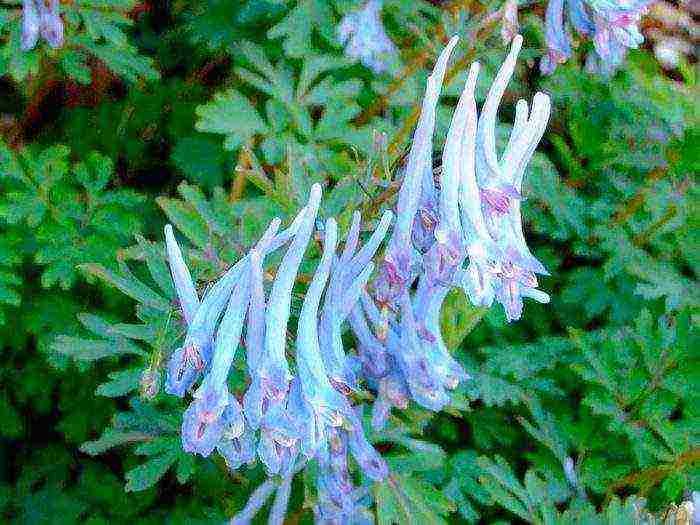
Corydalis are highly resistant to disease, so they rarely get sick. If there is stagnation of water in the root system, then this can cause the development of a fungal disease. Any culture can become infected with a viral disease, no matter how badly or well you care for it. Bushes affected by such a disease should be removed from the soil and destroyed, and the area where they were grown must be spilled with a solution of potassium manganese, which must be strong enough. To cure a plant affected by a fungal disease, it must be sprayed with a fungicide solution.
Of the pests, mice and moles pose a danger to the corydalis. To get rid of them, bait with poison must be placed on the surface of the site in several places.
Types and varieties of corydalis with photos and names
Specialists divide a large number of crested species according to environmental requirements that determine the type of agricultural technology. Forest species are the most unpretentious of all perennial corydalis species, for example: Bush's corydalis, smoky-leaved, large-flowered (giant), Magadan, low, deceptive (doubtful), intermediate, narrow-leaved, dense (Hallera), Caucasian, Kuznetsova, Marshall, Malka, bracts and placed (Turchaninov). For the cultivation of these species, it is recommended to choose areas with clay or sandy loam soil, saturated with leaf humus and humus. They grow best in grass in a clearing under deciduous trees, in a garden under fruit crops, as well as in permanent flower beds.
The most popular varieties are Haller's corydalis (dense), for example:
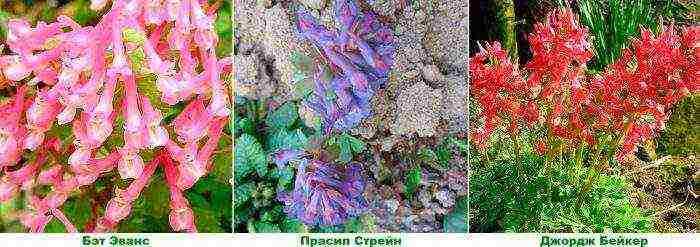
- Beth Evans... The flowers are painted in a delicate shade of pink, while the spur is white.
- Prasil Strain... It is a mixture of varieties with flowers colored in various shades from salmon and pink to red.
- George Baker... The flowers are deep red, almost cherry-colored.
- Dieter Schacht... The flowers are pale pink.
- Highland Mix... Inflorescences are painted in a smoky pinkish-blue color.
- Munich Form... The flowers are colored coral red.
- Nettleton Pink... The inflorescences have a deep pink color.
Perennial species of the Himalayan deserts, highlands and foothills are less adapted for cultivation in the middle latitudes. They received a conditional name - mountain species. These include: Wilson's crested, Darvaz, Ledebour, Narinyan, Popova, rut-leaved, Severtsova, Emanuel, Kashmir, holosteel, large-spine, Maracandan, Pachosky, dissected-leaved, glaucous and Shangin.
Perennial rhizome species include sulfur-yellow, yellow and noble corydalis.Annual species are much less often cultivated, for example: touch-me-not corydalis and evergreen.
Not so long ago, highly decorative species from the Chinese region of Sichuan began to be cultivated in Europe, namely: the corydalis high and winding. The most popular are the following varieties of Corydalis sinuous:

- Blue Panda... The leaf plates are colored in a light green-blue hue. The flowers are azure, the spurs are bent.
- Pearl Leaf... The color of the leaf plates is violet-red. On the shoots at the base of the leaves, there are spots of dark red color.
- China Blue... In winter, the foliage is green-brown. The length of the azure-greenish flowers is about 31 centimeters.
- Balang Mist... The color of the flowers is bluish.
Read the content of the article!
Corydalis: photo, reproduction, planting and care in the open field. The Corydalis plant is not one of the most beautiful flowering perennial crops. But it releases the first inflorescences in early spring. The flower is often used in decorating personal plots. Planting and caring for the corydalis is not difficult, but it has some nuances.
Corydalis: description of the plant
The main value of the Corydalis or Corydalis: with its help you can decorate the bare April area. The flower begins to grow even under the snow, in March, and blooms even at +3 ° C on the soil. You will succeed in a motley crested flower bed even in the shady zone. The flowering period is about 3 weeks. A seed box is formed in place of the flower. The main seed distributors are ants.
Note! Corydalis is planted with tubers. It is in them that nutrients are subsequently accumulated for the beginning of the early vegetation of the plant.
Corydalis characteristics:
- Bright flowers are another of her business cards. The combination of shades depends on the variety, of which the culture has more than 300.
- A characteristic feature of the corydalis is the same structure of flowers. They consist of 4 petals. The ends of the outer pair are bent. Moreover, the upper petal has a spur - a long process at the base, in which nectar is formed. A pair of inner petals are spliced and protrudes slightly due to the fold of the outer ones.
- Flowers are combined in a racemose inflorescence. In some varieties - in a single version.
- Corydalis flowers smell good when the air warms up under the May sun.
- The leaves have a delicate lace shape. Type - fern-like, double- or triple-complex. The color is bright green, sometimes with a slight yellow tint. In some corydalis, several scaly leaves grow at the base. They protect the stem.
- The height varies greatly depending on the variety: from 5 cm to 1-1.5 m.
Note! Corydalis is an excellent honey plant. In addition, it is actively used in traditional medicine.
Corydalis varieties, decorative use
A pleasant-looking culture has a large varietal variety. The most popular among domestic florists are:
- Caucasian. Forms pink-lilac loose inflorescences.
- Hollow or tuberous. Produces a high peduncle. The brush rises above the green foliage. Color - shades of lilac. Rarely white.
- Crested Marshall. Similar to Paula, only the flowers are pale cream or yellowish pink.
The height of popular varieties is about 30-40 cm in adulthood, so it is convenient to combine and combine them as a decorative mosaic in one flower bed. Due to its light unpretentiousness, culture is universal in landscape design. Planting the corydalis will decorate the bare ground in the near-trunk circle under the spreading trees, where even after wilting there will be ground cover greens pleasant to the eye. The flower is used in compositions on stone and pebble landscape elements, in alpine hills, for framing garden paths. You can see examples in the photo. Culture is also in demand in the creation of a butterfly garden.
Note! Today, new hybrids with excellent decorative properties and adaptation to the climate of the Russian Federation are on sale.
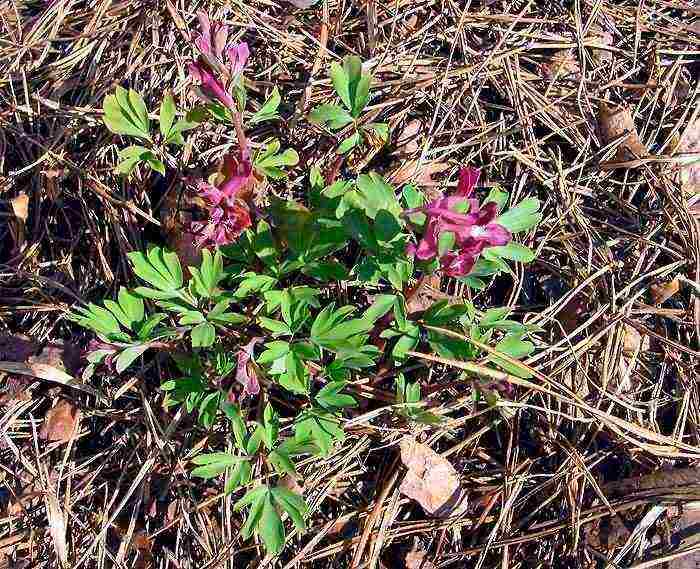
Caucasian
Corydalis planting. Breeding features
If you do not have tubers of this crop on hand, you can buy them at a flower shop. Good planting material appears around August-September. This is the period when the harvested tubers of faded plants entered the dormant stage and underwent the necessary training. Later, in the fall, they will turn from hard and juicy to wrinkled, flabby and become unsuitable for reproduction.
Plant the corydalis immediately after receiving the tubers. Caucasian, hollow and other forest varieties are deepened by about 6-8 cm, new Chinese varieties - by 12-13 cm. Forest varieties love loose soils saturated with organic fertilizers. Chinese grow eagerly in heavy clay soils (subject to good drainage).
Useful advice! Corydalis of classic varieties are best planted in the shade or partial shade. And modern hybrids need more light.
In the open field, the plant can be propagated by seed. They take root well and sprout:
- collect boxes in a green state, but already with black seeds inside (boxes should be easy to open);
- sow immediately after ripening, which occurs 2 days after harvest;
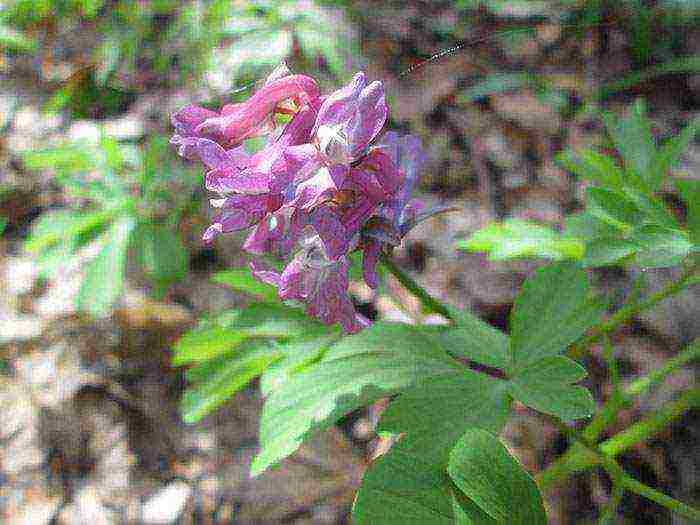
- slightly deepen the seeds into the soil (pot or container);
- be sure to regularly moisten crops and seedlings that appear in the spring.
Note! If you miss the moment of collecting the seed, you risk losing all the seeds. When the boxes ripen and open themselves, ants will take them away.
Plant care
Depending on the cultivar, Corydalis not only has a perennial tuber that can be dug up and replanted every year until it ages. Among the varietal diversity, there are plants with a removable root. Every year, a new one grows inside the old one, which must be transplanted. Be that as it may, after the flower withers, you should dig out its underground part. It doesn't matter if you delay with this procedure for a couple of weeks - the tubers will not suffer from moisture or heat. After digging, the material must be dried for a while.
Note! If it is badly needed, the culture is often transplanted even during flowering, cutting off the green part. In this case, the transplant is performed together with an earthen lump.
The enemies of the corydalis are similar to pests of snowdrops and crocuses: rodents, moles, diseases characteristic of low temperatures. Use the same prevention methods. And the rest of the plant will stand up for itself. Corydalis has a lot of advantages and at the same time does not require any frills in cultivation.
Perennial crested: video
Country house
